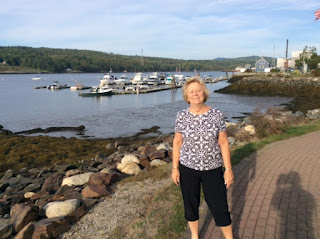Once
again, here is my favorite of all of the hike journals - Jim's
epilogue. This time I really believe that this epilogue is the best one
of all.
I will echo a portion of what I posted on Facebook recently, "I am blown away by my husband’s dogged determination when he sets a
goal. He began in Key West, FL on March 11, 2014 -
the southernmost point in the continental US. His goal was to walk to
Lubec, ME, the easternmost point. With two long hikes a year for four
years he reached Lubec on Oct. 6 - a total of 2,466 miles!!! Jane
From September 6 to October 6 I walked 250 miles across the
state of Maine.
Of those 30 days, I spent only 17 actually walking, as we broke this section
into three segments, each 5-7 days in length. Although it requires more driving
time, dividing a three-week hike into multiple segments provides the important
benefit of giving my body some time to rest and recover.
One highlight of the Maine
segment was hiking over 50 miles on the Down East Sunrise Trail. Although the
surface was too loose in many places and ATV traffic was a minor annoyance, I
did appreciate being able to get away from cars and trucks on the roads. Some
days on the DST I was in remarkably remote territory, with little evidence of
civilization for many miles at a time. It was a bit disappointing to not
observe more wildlife, but seeing the frolicking otters and a fox was really
special.
September and early October are a great season to be
outdoors, with comfortable temperatures, low humidity, and very little rain to
contend with. The visuals were outstanding, with wildflowers blooming, apple
and crabapple trees and wintergreen heavy with their fruit, and the leaves
becoming more colorful with each passing day. The last several days in early
October were truly spectacular, with brilliant reds, oranges and yellows mixing
with the green of pines and spruces. There was so much more color in that part
of Maine than
we found at home in central NH.
In the two previous sections of the hike – in Conn., Mass.,
and NH – I was fortunate to have the company of friends for many of the miles
in those states. But this section I was alone, except for my ever-reliable Jane
who was kind enough to frequently interrupt her days to meet me for lunch at a
local restaurant. We did eat well on this trip – three meals a day with plenty
of local seafood. We stayed seven nights at five B&Bs, and the breakfasts
those days were fantastic.
The last week of the hike we were in Down East Maine, where the
principal crop is low-bush (aka “wild”) blueberries. Due to a combination of
climate and soil, blueberries grow like weeds here, and with a little attention
they will cover the fields and hillsides for acres. We learned a lot about wild
blueberries while passing through this area. For example,
-
They are harvested every other year, which keeps the
plants and the land they grow on healthy.
-
They have a more intense flavor than cultivated
blueberries, and double the antioxidants.
-
During the spring bloom, thousands of bee hives are
brought in by growers to pollinate the plants.
-
99% of the harvested berries are flash frozen so they
can be enjoyed year-round.
-
After harvest season, growers cover the bushes with
straw, which the following Spring is set afire to burn the bushes to the ground
for their fallow year.
So the truck and trailer that Jane met on grass-covered General Cobb Road
was full of straw that would be blown out over the fields of blueberries. On
our return trip home, we actually saw that being done on another blueberry
field.
My final leg of the hike up the East Coast is now history.
It took me eight sections averaging over 300 miles each over four years to walk
from southern-most Florida
to the Canadian border. While nowhere near as long and lonely as my hike across
the country that ended in 2013, it was nonetheless an epic adventure. My logs
indicate it took me 156 days (five months!) of hiking and an estimated 5.25
million steps to go from Key West
to Lubec. I will forever cherish memories of countless cities and towns through
which I traveled and the people we met along the way, many of whom fed us and
let us stay with them overnight.
I recently was invited to speak to a group about my
long-distance hiking adventures. My comments included the reasons why I am a
long-distance hiker. I spoke of the educational benefits of traveling, especially
the historical and geographical things I learned which you would miss by
driving. As readers of this journal can attest, I really love to observe the
amazing beauty of our country, including the great variety of plant and animal
life visible to a hiker from the side of the road. And I related the lessons I
have learned from doing these long walks:
1) make do with less comfort and technology than you might
want, and have faith that somehow you will get what you need;
2) keep a positive attitude – expect the best and usually
you will get it; and
3) dealing with challenging situations makes us better
people.
As I got farther north over the last several years, I have
made it an objective to choose routes
that keep me away from heavily trafficked highways as much as possible.
Although major state roads usually have wide paved shoulders, it is healthier
and safer to walk on soft roadsides with fewer cars and trucks passing by. And
better still are the converted rail trails that I found in the New England states. These are surprisingly common today,
and I would urge you to find ones that exist near you. That can be done online (www.railstotrails.org) and there are
excellent books available (www.wildernesspress.com)
that describe in great detail all rail trails in a region (e.g., New England, Mid-Atlantic, and Southeast).
Of necessity the hike journals are written hastily, typically
at the end of a day after hiking 15-20 miles. It is my sincere hope that these
walks and the journals that describe them have been an inspiration to those
that read them. It has been a pleasure to share my experiences along the way,
and the joy I derive by walking the roads and trails and observing the wonders
of the natural world.
It should be obvious that this 2500 mile hike would not have
been possible without the support of Jane.
She has dedicated about four months of her life to make it possible for
me to walk northward these last four years. She has asked for a break from
these semi-annual adventures, so my hike next Spring will likely be done
without Jane. I have begun discussions to create a long group hike with support
from one or possibly two hiker organizations…details to follow at a later date.





























